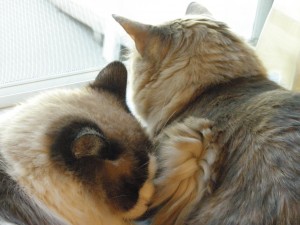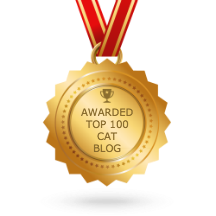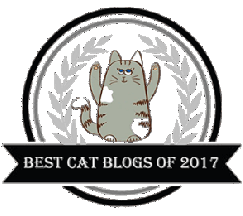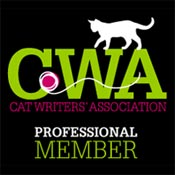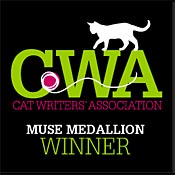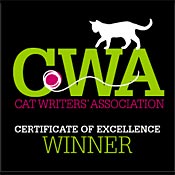For the next fifteen years, still with an array of cats at my side, in my office, on my lap, dancing on the keyboard…I embedded myself in the world of publishing as a teacher, workshop leader, speaker, and consultant. I studied constantly to keep up with the ever-changing industry. I collected resources. I attended and spoke at major writing/publishing conferences throughout the U.S. (San Francisco, Dallas, Los Angeles, St. Louis, New York, etc.). And I wrote nearly two dozen books and hundreds and hundreds of articles for authors. I became the President and then Executive Director of SPAWN (Small Publishers, Artists and Writers Network) and I wrote around 100 issues of the meaty monthly SPAWN Market Update. I also established my publishing blog which I posted to daily for several years.
I was the go-to person for many countless authors who were starting out or struggling in the hugely competitive, out-of-control world of publishing. I remember reading years ago that some 80 percent of people felt they had a book in them. Well, this was the era when the majority of them began writing that book on their new-fangled home computers.
Numbers of printers, businesspeople, and others from a wide variety of professions and backgrounds, began establishing publishing-related businesses, such as publishing, editorial, and book marketing services. There had always been vanity publishers—those who would produce your book for a fee. But by the year 2004, there were around 100 of these hybrid publishing services designed to help legitimate authors as well as those with sub-standard book projects to become published.
My goal during those years and the purpose of SPAWN was to educate authors so they made the best decisions on behalf of their publishing projects. The thing is, many countless hopeful authors were entering into the publishing arena unknowingly bent on failure because they were uninformed. They didn’t understand enough about the industry to make the best decisions. So the failure rate for authors rose and continues to rise considerably. I read recently that this failure rate has risen from around 76 percent to 93 percent.
During this seventeen year span, I also had the pleasure of editing dozens and dozens of books both nonfiction and fiction. Now, I’d never been much for reading fiction and I certainly had no desire to write fiction. From the beginning of my writing/publishing path, I’ve been all about nonfiction—“give me the facts, ma’am.” My reading choices were informational books and newsletters related to a topic of my interest—in those days, mostly publishing and book marketing. I read true stories about cats, biographies, how-tos, historicals… And then an author brought me a novel.
I intended recommending another editor, because I did not edit fiction. However, when I took a look at this story, I was somehow drawn in. I saw immediately some of the problems with the way it was written and knew somehow instinctively how to remedy them. I discovered that I actually had an eye for fiction and a knack for editing it. My biggest surprise was how much I enjoyed the editing process for fiction.
So my editorial shingle became a welcome mat for novelists as well as nonfiction writers and I edited numbers of them during that period. I even started reading fiction!
Throughout my career, I’d say, “Someday I’m going to try writing fiction.” But I didn’t take myself seriously…until my birthday in June of 2012.
I’ve learned throughout my relatively long life the importance of honoring oneself. I’ve taken this lesson to heart. To this day, I find some significant way of celebrating myself on my birthdays. A memorable example of this is the year I found a litter of feral kittens in our woodshed. What a joy-filled gift that was. Max, the only boy in the litter, is taking up my lap as I type this. He’s a beautiful snow-shoe-type sixteen year-old now.
So let’s go back to my birthday in June of 2012. That’s the day I decided to give myself the time and space to try writing a book of fiction. Deciding on the storyline took a little while. I knew it would involve cats and I was pretty sure I wanted to write a light mystery. I’d been reading light mysteries. That’s how I would describe them. Come to find out, these books I’d been reading on my Kindle fit into a bona-fide genre. They are considered cozy mysteries. That’s what I wanted to write. But how would I go about it? How would I develop a story? What theme would I pursue? It’ll be a mystery and there’s a cat in it—then what? How would I make my book unique and still fit into the genre?
How, indeed? Watch for additional segments to this story, which began January 6, 2015. Learn how I became a published author. Discover what prompted my reputation as a key player in the publishing arena. Find out what inspired me to shift gears completely and start writing fiction—the Klepto Cat Mystery series, in particular—and why they’re selling so well.
If you have any questions or comments along the way, please direct them to me at PLFry620@yahoo.com. Or leave a comment here.
In the meantime, check out my Klepto Cat Mystery series—now eight books strong—here: http://amzn.to/1kAI8I2

